History
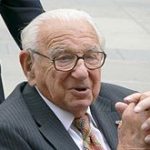 His name was Sir Nicholas George Winton MBE, but in his early years, he had not been bestowed with such an honor as knighthood. That came about much later in his life. Sir Winton was born on May 19, 1909 in Hampstead, London, England. He was a British humanitarian, born to German-Jewish parents, Rudolph Wertheim (1881–1937), a bank manager, and his wife Barbara (née Wertheimer, 1888–1978) who had emigrated to Britain. His parents had moved to London two years before he was born. The family name was Wertheim, but they changed it to Winton in an effort at integration. They also converted to Christianity, and Winton was baptized. God had a plan for Sir Winton’s life, although he would not know that for years.
His name was Sir Nicholas George Winton MBE, but in his early years, he had not been bestowed with such an honor as knighthood. That came about much later in his life. Sir Winton was born on May 19, 1909 in Hampstead, London, England. He was a British humanitarian, born to German-Jewish parents, Rudolph Wertheim (1881–1937), a bank manager, and his wife Barbara (née Wertheimer, 1888–1978) who had emigrated to Britain. His parents had moved to London two years before he was born. The family name was Wertheim, but they changed it to Winton in an effort at integration. They also converted to Christianity, and Winton was baptized. God had a plan for Sir Winton’s life, although he would not know that for years.
On the eve of World War II, Sir Winton knew what his calling had been, and he quietly set about orchestrating the rescue of 669 children, most of them Jewish, from Czechoslovakia. Sir Winton quickly found homes for the children and arranged for their safe passage to Britain. The operation was known as the Czech Kindertransport, which is German for “children’s transport, but it would not be called that right away. The transport was not a official operation, and was not sanctioned as such. He worked largely alone to set this up, and most people knew nothing about it for over 50 years, but the children did not forget the man they called the British Schindler, who had saved their lives.
Then, in 1988, he was invited to the BBC television program “That’s Life!.” It was a surprise party of sorts. Little 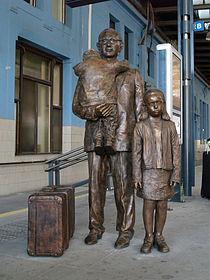 did Sir Winton know, but his secret was no longer such a secret. Arriving at the show, Sir Winton was seated in a room full of people he did not know. Soon, the truth was told to him, and he found out that the “audience” was in fact a number of the children he had rescued all those years ago. The grateful children, now grown adults, wanted to reunite with the man who had saved then all those years ago. It was the British press who celebrated him and dubbed him the “British Schindler.” Sir Winton was brought to tears, as he looked around him at all of these people who owed him their very lives, but his story did not end there. In 2003, Nicholas Winton became Sir Nicholas George Winton MBE (Most Excellent Order of the British Empire), when he was knighted by Queen Elizabeth II for “services to humanity, in saving Jewish children from Nazi Germany occupied Czechoslovakia.” Then, on October 28, 2014, he was awarded the highest honor of the Czech Republic, the Order of the White Lion (1st class), by Czech President Miloš Zeman. The little German-Jewish boy, whose family converted to Christianity, and who always felt a love for humanity and those in need, had become a great man indeed. God did have a plan for his life, and Sir Winton had made God proud. Sir Nicholas George Winton MBE passed away peacefully in his sleep on July 1, 2015, at Wexham Park Hospital, Slough, Berkshire, England, at the age of 106 years, having lived a full life. After the war, Winton worked for the International Refugee Organization and then the International Bank for Reconstruction and Development in Paris, where he met Grete Gjelstrup, a Danish secretary and accountant’s daughter. They married in her hometown of Vejle on October 31, 1948. The couple settled in Maidenhead, England, where they raised their three children: Nick (born 1951), Barbara (born 1954) and the youngest Robin (1956–1962), who was born
did Sir Winton know, but his secret was no longer such a secret. Arriving at the show, Sir Winton was seated in a room full of people he did not know. Soon, the truth was told to him, and he found out that the “audience” was in fact a number of the children he had rescued all those years ago. The grateful children, now grown adults, wanted to reunite with the man who had saved then all those years ago. It was the British press who celebrated him and dubbed him the “British Schindler.” Sir Winton was brought to tears, as he looked around him at all of these people who owed him their very lives, but his story did not end there. In 2003, Nicholas Winton became Sir Nicholas George Winton MBE (Most Excellent Order of the British Empire), when he was knighted by Queen Elizabeth II for “services to humanity, in saving Jewish children from Nazi Germany occupied Czechoslovakia.” Then, on October 28, 2014, he was awarded the highest honor of the Czech Republic, the Order of the White Lion (1st class), by Czech President Miloš Zeman. The little German-Jewish boy, whose family converted to Christianity, and who always felt a love for humanity and those in need, had become a great man indeed. God did have a plan for his life, and Sir Winton had made God proud. Sir Nicholas George Winton MBE passed away peacefully in his sleep on July 1, 2015, at Wexham Park Hospital, Slough, Berkshire, England, at the age of 106 years, having lived a full life. After the war, Winton worked for the International Refugee Organization and then the International Bank for Reconstruction and Development in Paris, where he met Grete Gjelstrup, a Danish secretary and accountant’s daughter. They married in her hometown of Vejle on October 31, 1948. The couple settled in Maidenhead, England, where they raised their three children: Nick (born 1951), Barbara (born 1954) and the youngest Robin (1956–1962), who was born 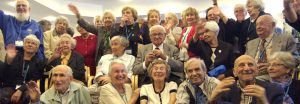 with Down syndrome. At the family’s insisted Robin stayed with them, rather than being sent to a residential home. Sir Winton’s son, Robin died of meningitis, the day before his sixth birthday. The death was devastating for Winton and he founded a local support organization that later became Maidenhead Mencap. Winton stood, unsuccessfully, for the town council in 1954, but later found work in the finance departments of various companies. His wife, Grete preceded him in death in 1999. Sir Nicholas George Winton MBE was a truly remarkable man.
with Down syndrome. At the family’s insisted Robin stayed with them, rather than being sent to a residential home. Sir Winton’s son, Robin died of meningitis, the day before his sixth birthday. The death was devastating for Winton and he founded a local support organization that later became Maidenhead Mencap. Winton stood, unsuccessfully, for the town council in 1954, but later found work in the finance departments of various companies. His wife, Grete preceded him in death in 1999. Sir Nicholas George Winton MBE was a truly remarkable man.
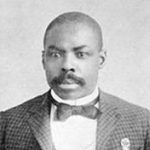
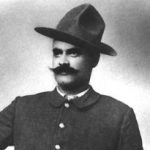 Seldom does it happen that money from a robbery is never recovered, but that is the case for approximately $28,000 in gold and silver coins, which have been missing for more than a century. The money came from the little known Wham Paymaster Robbery, which occurred near Pima, Arizona. Eight suspects were caught and tried for the crime, but in the end, they walked away free men. The circumstances of the robbery remain an unsolved mystery to this day. The robbery of US Army Paymaster, Major Joseph Washington Wham occurred on May 11, 1889 in the early morning hours. Wham was preparing to make the trip from Fort Grant to Fort Thomas to pay the soldiers’ salaries. The day before, he had distributed the pay to Fort Grant. That day, he was to pay the men at Fort Thomas, Camp San Carlos, and Fort Apache.
Seldom does it happen that money from a robbery is never recovered, but that is the case for approximately $28,000 in gold and silver coins, which have been missing for more than a century. The money came from the little known Wham Paymaster Robbery, which occurred near Pima, Arizona. Eight suspects were caught and tried for the crime, but in the end, they walked away free men. The circumstances of the robbery remain an unsolved mystery to this day. The robbery of US Army Paymaster, Major Joseph Washington Wham occurred on May 11, 1889 in the early morning hours. Wham was preparing to make the trip from Fort Grant to Fort Thomas to pay the soldiers’ salaries. The day before, he had distributed the pay to Fort Grant. That day, he was to pay the men at Fort Thomas, Camp San Carlos, and Fort Apache.
Wham, along with his clerk, William Gibbon, and Private Caldwell, his servant and mule tender, climbed into a canopied wagon driven by Buffalo Soldier, Private Hamilton Lewis for the 46 mile trip to Fort Thomas. The payroll Wham was still in possession of was more than $28,000 in gold and silver coins. It was locked in an oak strongbox in the wagon. Given the amount of money Wham was carrying, he was heavily escorted by nine Buffalo Soldiers of the 24th Infantry on horseback, as well as a wagon that carried two privates of the 10th Cavalry (also an African-American regiment) that was driven by a civilian employee of the Quartermaster Department. Everyone was heavily armed, except Wham, his clerk and the two drivers. An African-American female gambler named Frankie Campbell, joined them at the last minute. She wanted to ride along with them to be in Fort Thomas when the soldiers got paid…to stir up a game or two, I’m sure.
About 15 miles west of Pima in the Gila River Valley, just after midday, the caravan came to a stop. A large boulder was blocking the road, and the wagons were unable to get around it. The soldiers lay down their weapons in order to dislodge the large rock. They barely got started when a cry came from a ledge some 60 feet above on the adjacent hill, “Look out, you black sons of bitches!” and bullets began to hail down upon the soldiers. Three of the 12 mules pulling the wagons were killed and the other animals panicked, rearing and pulling both vehicles off the road. The soldiers ran for their guns and took cover to fight the barrage of bullets raining down on them from the hills. Sergeant Benjamin Brown was shot but continued to return fire with his revolver. Private James Young ran through heavy gunfire and carried Brown more than 100 yards to safety. Corporal Isaiah Mays then took command, ordering the entourage to retreat to a creek bed about 300 yards away, while Major Wham strongly protested. The battle continued to rage on for about a half an hour as the soldiers valiantly tried to protect the payload. However, eight of Wham’s eleven-man escort were severely wounded and the battle had become extremely one-sided. During all this, gambler, Frankie Campbell, who had been riding ahead of the caravan, had been thrown from her horse and had taken cover.
With the soldiers hidden, wounded, and severely out gunned, five bandits then made their way to the wagon. Once there, they cracked the strongbox with an ax, and carried off the U.S. Treasury sacks filled with the coins. The soldiers counted 12 outlaws, who made their escape. At about 3:00pm those, who could manage, made their way from the creek bed to the wagons. They spliced harnesses together, gathered some of the surviving mules, and finally made their way to Fort Thomas, arriving about 5:30pm. The soldiers left, Frankie Campbell to tend to the severely wounded, including Sergeant Benjamin Brown. These men would be brought in later. Amazingly, all of the soldiers would survive their wounds, so she must have done a good job with their care.
Amazingly, several of the bandits, who had not thought to cover their faces during the gun battle, were recognized and very soon arrested. US Deputy Marshal William Kidder Meade, and the Graham County Sheriff arrested 11 men, most of whom were citizens of Pima, Arizona. Seven were bound over for trial. The men were Gilbert Webb, the Mayor of Pima at the time. Webb was the suspected leader of the gang. Also arrested was his son, Wilfred. These men were already suspected of numerous thefts in the area. Along with the Webbs, brothers Lyman and Warren Follett, as well as David Rogers, Thomas Lamb, and Mark Cunningham, all of whom worked as cowboys for Gilbert Webb. Strangely, the men were charged with the robbery, but no one was ever charged with the shooting.
The trial in Federal Court in Tucson was held in November lasted 33 days. It was big news in the Southwest. With all the witnesses, I cant figure out how they could not be found guilty, but from the beginning, the trial involved major politics and infighting, including removing the original judge. In all, 165 witnesses testified at the trial, including five Buffalo Soldiers who identified three of the accused. Another witness testified that he had personally seen some of the men hiding the loot in a haystack and burning the US treasury sacks. Several other witnesses testified that they had seen members of the accused in the area of the ambush the day before…probably setting up their “hideouts” from which the ambush took place. Strangely, Frankie Campbell, who had stated she recognized several of the bandits, including the leader, Gilbert Webb, was never called to testify. The defense lawyer was the famed Marcus Aurelius Smith, and in the end all of the men were acquitted.
Afterward, it was widely claimed that political pressure from the acting governor allowed the thieves to go free. The entire case was a hotbed of religion, racism, and politics, as Pima, Arizona was founded as a Mormon Colony, of which Gilbert Webb was the mayor, one of the most influential men in the area, and came from a long line of pioneer Mormons. He was also known in the area as a generous man, providing jobs for struggling neighbors, extending credit, and providing provisions. Though most of the other accused men were not Mormons, they all lived in the Mormon colony, having many ties to the church through friends and relatives. Be it politics or religion, a great injustice was done that day. Many locals viewed the robbery and trial as an embarrassing disgrace to the town and its people, and to talk about it about might offend friends or neighbors, or bring shame upon the colony. Therefore, the robbery was kept largely under wraps. The locals called the robbers “Latter-Day Robin Hoods.”
In the meantime, Major Joseph Washington Wham, as the commanding officer, was held accountable for the loss of the money but was later absolved of any guilt. Two of the Buffalo Soldiers were awarded the Medal of Honor for their part in the gun battle with the bandits. Although shot in the abdomen, Sergeant Benjamin Brown continued the fight until he was further wounded in both arms. Corporal Isaiah Mays also received the Medal of Honor, as near the end of the gun battle, though shot in the legs, he “walked and crawled two miles to Cottonwood Ranch and gave the alarm.” Other Buffalo Soldiers cited for bravery in the incident received the Certificate of Merit. These included Hamilton Lewis, Squire Williams, George Arrington, James Wheeler, Benjamin Burge, Thomas Hams, James Young, and Julius Harrison of the 10th Cavalry and 24th Infantry. US 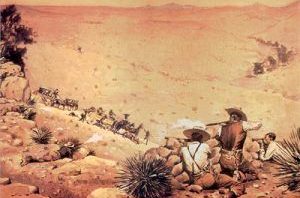
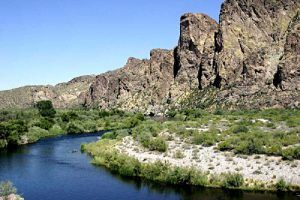 Deputy Marshal Meade, who would bring in the bandits, would say of the soldiers, “I am satisfied a braver or better defense could not have been made under like circumstances.” Throughout the years, the robbery has created a number of various treasure tales, suggesting that some of the coins are still hidden in the area somewhere. However; with all of the suspects set free, this would seem doubtful.
Deputy Marshal Meade, who would bring in the bandits, would say of the soldiers, “I am satisfied a braver or better defense could not have been made under like circumstances.” Throughout the years, the robbery has created a number of various treasure tales, suggesting that some of the coins are still hidden in the area somewhere. However; with all of the suspects set free, this would seem doubtful.
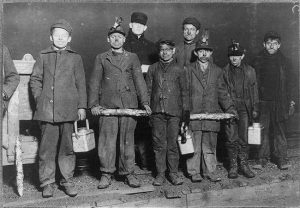
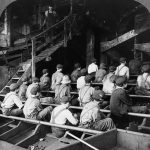 Most of us have heard, either from our dads, grandfathers. or great grandfathers about how they or their ancestors had to quit school at an early age to work and help support the family. Life at the turn of the 20th Century was not easy. With the great depression, and poverty everywhere, and no real child labor laws, and the Industrial Revolution in full swing, the kids had little choice but to go out and help their families put food on the table. At that time in history, there were no real child labor laws in place, and there was a need that had to be filled. Whole families were in danger of starvation. The family had to get some money soon. Exceptions were made.
Most of us have heard, either from our dads, grandfathers. or great grandfathers about how they or their ancestors had to quit school at an early age to work and help support the family. Life at the turn of the 20th Century was not easy. With the great depression, and poverty everywhere, and no real child labor laws, and the Industrial Revolution in full swing, the kids had little choice but to go out and help their families put food on the table. At that time in history, there were no real child labor laws in place, and there was a need that had to be filled. Whole families were in danger of starvation. The family had to get some money soon. Exceptions were made.
Because of the circumstances of the times, and the need to eat, the nation’s children went to work. They worked in coal mines, factories, agriculture, and every other menial job they could get. So many of these jobs would have detrimental affects on the health of the workers. It was not unusual to find whole families or father-son pairs who were hired together. Unfortunately, children were not given jobs that suited their status as young, impressionable people who aren’t able to really care for themselves, much less do a skilled job. The child laborers were often given the jobs adults physically couldn’t accomplish. That sounds strange to us, but it meant crawling into tiny places the adults could not fit through. As an example, in factories, children were sent into the tiny, cramped interiors of the machines. Their task was to fix mechanisms that the adults simply couldn’t reach. This was dangerous work, and even with doing things the adults couldn’t, children received lower pay than the adults who depended on them.
The small stature of the children ensured that they often had the most dangerous jobs available in the coal mines too. As greasers, the children were constantly in danger of being crushed by carts loaded down with coal, as they ran up and down the tram tracks, a heavy bucket of grease on each arm, making sure the tram axels were appropriately greased at all times. Nippers (also called trappers) were children who had the dangerous responsibility of opening and closing the shaft doors as coal cars came hurtling down the sloped tracks. Boys who fell asleep in the total stillness and darkness…sometimes a mile beneath the surface…would be crushed if they failed to lift the door.
Eventually, activists began to take issue with the treatment of children in positions like these. One photographer…Lewis Hine made it his personal mission to document the situation of children in the coal fields of 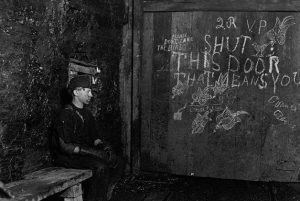
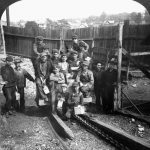 Appalachia. Because of his persistence, we have a cache of images documenting this era of American child labor. These and many other images led the US government to pass the Keating-Owens Child Labor Act of 1916. The act created a minimum age of 16 for mine workers, as well as instating the eight-hour workday. Then, shockingly, this act was deemed unconstitutional. The child labor issues continued until the 1930s, when the New Deal brought permanent reform for child laborers.
Appalachia. Because of his persistence, we have a cache of images documenting this era of American child labor. These and many other images led the US government to pass the Keating-Owens Child Labor Act of 1916. The act created a minimum age of 16 for mine workers, as well as instating the eight-hour workday. Then, shockingly, this act was deemed unconstitutional. The child labor issues continued until the 1930s, when the New Deal brought permanent reform for child laborers.
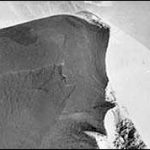
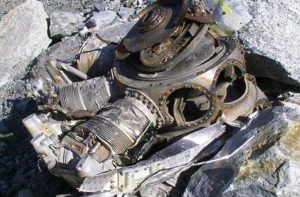 All seemed normal that January 24th, 1966 as the Air India Flight 101, a Boeing 707 was making its regular run from Bombay to New York, but it was not truly a normal flight at all. In reality, the plane was too low, and to make matters worse, there was a fog bank hanging over Mount Blanc in the Alps. There were 117 people onboard the plane, when it careened into the side of the mountain at 8:00am local time, hitting just fifty feet below the summit. If only they could have been fifty feet higher, it would have been just a very close call.
All seemed normal that January 24th, 1966 as the Air India Flight 101, a Boeing 707 was making its regular run from Bombay to New York, but it was not truly a normal flight at all. In reality, the plane was too low, and to make matters worse, there was a fog bank hanging over Mount Blanc in the Alps. There were 117 people onboard the plane, when it careened into the side of the mountain at 8:00am local time, hitting just fifty feet below the summit. If only they could have been fifty feet higher, it would have been just a very close call.
The plane was preparing to land at the Geneva Airport in Switzerland. Onboard was the Indian Atomic Energy Commission, Dr Homi Jehangir Bhabha, who was on his way to Vienna. Six passengers were British, and the rest were Indian nationals…46 of those were sailors. The plane was a few minutes behind schedule as it made its descent, but the captain of the Air India Boeing 707, was one of the airline’s most experienced pilots, and all seemed well. The pilot had radioed the control tower a few minutes earlier to report that his instruments were working fine and the aircraft was flying at 19,000 feet, which was at least 3,000 feet higher than the Mont Blanc summit…but he wasn’t, or he was descending faster than he realized.
Rescue teams were dispatched immediately, and they found wreckage scattered on the south-west side of the Mount Blanc, about 1,400 feet below the summit. Mountain guide, Gerard Devoussoux, who was one of the first to arrive at the crash site, said: “Another 50 feet and the plane would have missed the rock. It made a huge crater in the mountain. Everything was completely pulverized. Nothing was identifiable except for a few letters and packets.” The site was devastating, and I’m sure the rescue teams felt sick at the sight of it. Planes that crash seldom leave bodies in one piece. French authorities radioed back the news that there was virtually no hope of survivors shortly after landing in the area.
When inclement weather moved in, the search had to be called off. The bad weather and poor visibility made the rescue efforts impossible. The airport quickly filled with relatives of the passengers involved in the disaster, all of whom were in tears after airport officials broke the news of the crash. Robert Bruce, from Tooting, who was waiting for his parents to arrive, said: “I am so choked I cannot even cry. I will just go home and collapse. As far as I am concerned my world has come to an end.”
The cause of the crash was determined to be pilot error. The pilot misunderstood the directions he was given with devastating results. Another crash had occurred at the same place 16 years earlier, killing 48 people. The  Alps are mountains that receive a lot of mountain climbing traffic every year. Over the years climbers have come across plane parts, as well as body parts. More recently, a young French alpinist approaching the summit of Mont Blanc, saw a metal box poking out of the ice and snow on the shoulder of western Europe’s highest mountain. The box contained precious gems…including emeralds, rubies, and sapphires…worth hundreds of thousands of euros. The box had been there for over 50 years. The honest climber turned the gems in to authorities, but no one has claimed them yet. If they remain unclaimed, the could be returned to the climber, who has not been named.
Alps are mountains that receive a lot of mountain climbing traffic every year. Over the years climbers have come across plane parts, as well as body parts. More recently, a young French alpinist approaching the summit of Mont Blanc, saw a metal box poking out of the ice and snow on the shoulder of western Europe’s highest mountain. The box contained precious gems…including emeralds, rubies, and sapphires…worth hundreds of thousands of euros. The box had been there for over 50 years. The honest climber turned the gems in to authorities, but no one has claimed them yet. If they remain unclaimed, the could be returned to the climber, who has not been named.
 These days there aren’t many people who haven’t heard of the Santa Ana winds, the California wildfires, or this year, the burning of Australia. We hear all about how global warming is the cause of the tragic fires and loss of both vegetation and life, human and animal. I agree with the analogy that the fires in Australia are horrific, but the cause…well, that has been determined to be, not global warming, draught, or lightning, but rather arson…ARSON!! Disgusting just isn’t a big enough word for what that is.
These days there aren’t many people who haven’t heard of the Santa Ana winds, the California wildfires, or this year, the burning of Australia. We hear all about how global warming is the cause of the tragic fires and loss of both vegetation and life, human and animal. I agree with the analogy that the fires in Australia are horrific, but the cause…well, that has been determined to be, not global warming, draught, or lightning, but rather arson…ARSON!! Disgusting just isn’t a big enough word for what that is.
I can’t imagine why anyone would choose to burn something…anything. You can call it a sickness, and maybe it is, but that cannot be an excuse. If we allow such an excuse, more and more people will use it, take out their frustrations on things around them, and then expect to be excused because they are “sick.” At this point, firefighters are battling wildfires across Australia. Meanwhile, the police in New South Wales have arrested  dozens of people for offenses related to fires, including 24 for deliberately lighting fires and three for looting fire-ravaged communities. There is also a story saying that 183 to 200 people are suspected of “fire-related offenses since November 8th, including for ‘allegedly discarding a lighted cigarette or match on land,’ but no verification as to the exact charges being lodged.
dozens of people for offenses related to fires, including 24 for deliberately lighting fires and three for looting fire-ravaged communities. There is also a story saying that 183 to 200 people are suspected of “fire-related offenses since November 8th, including for ‘allegedly discarding a lighted cigarette or match on land,’ but no verification as to the exact charges being lodged.
It is sad that the most common motive for wildfire arson is crime concealment. Fires are set for the purpose of covering up a murder or burglary or to eliminate evidence left at a crime scene. Fires have also been known to be set to further social, political, or religious causes. The fire set to cover up a crime, while horrific, is at least explainable, but fires set for political, social, or religious reasons is completely disgusting. There is just no excuse for the loss of homes businesses, and lives, human and animal, that could excuse such destruction. One fire, set to cover up a crime is reasonable, though disgusting, but these are all over Australia. And while one  person might be a “sick” arsonist, to find 24 to 200 “sick” arsonists, is not even possible. The other thought that makes me so mad I could scream, is that even if this is socially, politically, or religiously motivated, what is the point? What are they trying to prove? All I can say is, that I hope they find the people who did this and that they give them the maximum sentence possible. I don’t know Australian law, so I don’t know if they have the death penalty or not, but I think these people should get it, if they do. And if not, solitary confinement for the rest of their lives might…just might, be punishment enough, but I really doubt it.
person might be a “sick” arsonist, to find 24 to 200 “sick” arsonists, is not even possible. The other thought that makes me so mad I could scream, is that even if this is socially, politically, or religiously motivated, what is the point? What are they trying to prove? All I can say is, that I hope they find the people who did this and that they give them the maximum sentence possible. I don’t know Australian law, so I don’t know if they have the death penalty or not, but I think these people should get it, if they do. And if not, solitary confinement for the rest of their lives might…just might, be punishment enough, but I really doubt it.
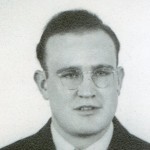 My uncle, Bill Spencer has always been a very interesting man, and I mean that in the very best sense of the word. I don’t know what kind of a student Uncle Bill was in school, but he has always loved learning, probably more so on his own than in a classroom. Somehow he doesn’t strike me as a kid who would have loved being in class, but I could be wrong. His passion was, of course, the family history, but Uncle Bill likes history to go along with his family history, and that is where my uncle and I are the most alike. My Uncle Bill worked meticulously and tirelessly on the family history, someday hoping to get it into the hands of the younger generation, which ended up being me and a few others who cared about it the same way he did…and for his hard work, I will be forever grateful.
My uncle, Bill Spencer has always been a very interesting man, and I mean that in the very best sense of the word. I don’t know what kind of a student Uncle Bill was in school, but he has always loved learning, probably more so on his own than in a classroom. Somehow he doesn’t strike me as a kid who would have loved being in class, but I could be wrong. His passion was, of course, the family history, but Uncle Bill likes history to go along with his family history, and that is where my uncle and I are the most alike. My Uncle Bill worked meticulously and tirelessly on the family history, someday hoping to get it into the hands of the younger generation, which ended up being me and a few others who cared about it the same way he did…and for his hard work, I will be forever grateful.
Much of my uncle’s knowledge about things was self-taught. He learned about antiques, guns, stamps, and 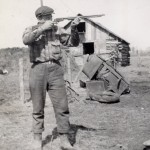 coins; and then he incorporated his knowledge into businesses he owned and ran. And he would pass his knowledge along to anyone who wanted to listen. It was Uncle bill who got me interested in stamps and coins, and while I don’t have large collections, I have a few that I like. I think it might have been his love of stamps, coins, and guns that sparked Uncle Bill’s interest in antiques, but I don’t know that for sure. His knowledge of family history and his Dad, Allen Luther Spencer’s ability to make furniture, might have had a part in that too. In addition, the era that my Uncle Bill was born into, did not have the ability to mass produce furniture like we have today, so the beautiful furniture pieces became one-of-a-kind works of art, and not just the useful, but cookie-cutter furniture on our day.
coins; and then he incorporated his knowledge into businesses he owned and ran. And he would pass his knowledge along to anyone who wanted to listen. It was Uncle bill who got me interested in stamps and coins, and while I don’t have large collections, I have a few that I like. I think it might have been his love of stamps, coins, and guns that sparked Uncle Bill’s interest in antiques, but I don’t know that for sure. His knowledge of family history and his Dad, Allen Luther Spencer’s ability to make furniture, might have had a part in that too. In addition, the era that my Uncle Bill was born into, did not have the ability to mass produce furniture like we have today, so the beautiful furniture pieces became one-of-a-kind works of art, and not just the useful, but cookie-cutter furniture on our day.
Uncle Bill is getting older now, and some of his recent memory escapes him, but the past remains vivid, at least  on his good days. The last time I saw him was a good day, and that made my sister, Cheryl Masterson, my cousin, Pam Wendling, and me very happy. His stories about the old days were vivid and full of knowledge, and any slips in his memory, were humorous and sweet, and still tied to people of the past. His advancing years, make me feel the urgent need to visit as often as I can, and my sisters, Cheryl, Caryl Reed, Alena Stevens, and I hope to make the trip late this upcoming summer for another visit. With each passing year, we just never know if Uncle Bill will still be with us. He isn’t the oldest sibling in his family, but he has lived the longest. Nevertheless, one day, he will no longer be with us. I pray that day is a long way off. Today in Uncle Bill’s 98th birthday. Happy birthday Uncle Bill!! Have a great day!! We love you very much!!
on his good days. The last time I saw him was a good day, and that made my sister, Cheryl Masterson, my cousin, Pam Wendling, and me very happy. His stories about the old days were vivid and full of knowledge, and any slips in his memory, were humorous and sweet, and still tied to people of the past. His advancing years, make me feel the urgent need to visit as often as I can, and my sisters, Cheryl, Caryl Reed, Alena Stevens, and I hope to make the trip late this upcoming summer for another visit. With each passing year, we just never know if Uncle Bill will still be with us. He isn’t the oldest sibling in his family, but he has lived the longest. Nevertheless, one day, he will no longer be with us. I pray that day is a long way off. Today in Uncle Bill’s 98th birthday. Happy birthday Uncle Bill!! Have a great day!! We love you very much!!

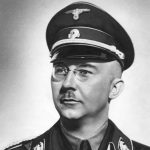 Anyone who knows much about World War II, and the Holocaust, knows the name Hermann Göring, who was Hitler’s second in command. We know names like Heinrich Himmler, Joseph Goebbels, Adolf Eichmann, and of course, Adolf Hitler. These men were among the worst of the evil Third Reich. Göring created the Gestapo as one of his first acts as a cabinet minister. He ceded it to Heinrich Himmler in 1934. Following the establishment of the Nazi state, Göring amassed power and political capital to become the second most powerful man in Germany. He was appointed commander-in-chief of the Luftwaffe…the Nazi air force, a position he held until the final days of the regime. He was later convicted of his crimes, but before he could be hanged, he committed suicide.
Anyone who knows much about World War II, and the Holocaust, knows the name Hermann Göring, who was Hitler’s second in command. We know names like Heinrich Himmler, Joseph Goebbels, Adolf Eichmann, and of course, Adolf Hitler. These men were among the worst of the evil Third Reich. Göring created the Gestapo as one of his first acts as a cabinet minister. He ceded it to Heinrich Himmler in 1934. Following the establishment of the Nazi state, Göring amassed power and political capital to become the second most powerful man in Germany. He was appointed commander-in-chief of the Luftwaffe…the Nazi air force, a position he held until the final days of the regime. He was later convicted of his crimes, but before he could be hanged, he committed suicide.
In July 1941, Hermann Göring, writing under instructions from Hitler, had ordered Reinhard Heydrich, SS general and Heinrich Himmler’s number-two man, to submit “as soon as possible a general plan of the administrative, material, and financial measures necessary for carrying out the desired final solution of the Jewish question.” This was the plan to murder millions of Jews, Gypsies, and Jehovah’s Witnesses. The meeting to discuss the plan that was later carried out was held on January 20, 1942. These evil men tortured and murdered all those people, with no remorse until the Allies finally put a stop to it all.
Many of the children and other relatives of the Nazi regime agreed with and even carried on the work after the original monsters were dead or imprisoned, but there were some who were so sickened by the things their monster relatives were doing that they shunned it at every turn. One such person was Albert Göring, the younger, and little-known brother of Reichsmarschall Hermann Göring, the notorious Nazi leader and war criminal, who was the exact opposite of his older brother. Albert was a Holocaust hero. He worked hard to save hundreds of Jews and political dissidents who were being persecuted by the very regime his brother had helped to create. With great personal risk. Albert was as anti-Nazi as he could be, and he raised his family the same 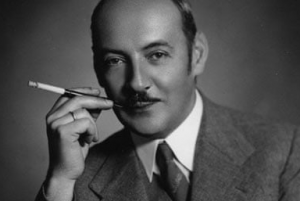
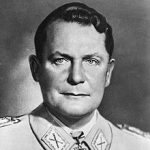 way. Bettina Goering, who was Hermann Göring’s great niece, apparently has similar features to Hermann Göring. That always bothered her. So much so, that she left Germany and immigrated to Santa Fe, New Mexico. She and her brother were so afraid that the “monster” gene was hereditary, that the both chose voluntary sterilization, so they would not bring any more Görings into this world. A drastic measure to be sure, but it was a decision they both knew they could live with.
way. Bettina Goering, who was Hermann Göring’s great niece, apparently has similar features to Hermann Göring. That always bothered her. So much so, that she left Germany and immigrated to Santa Fe, New Mexico. She and her brother were so afraid that the “monster” gene was hereditary, that the both chose voluntary sterilization, so they would not bring any more Görings into this world. A drastic measure to be sure, but it was a decision they both knew they could live with.
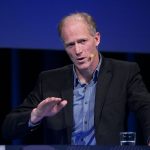 The ends of the earth…basically the poles…not exactly the most inviting places to visit…much less to cross alone. Still, there are always people who set lofty goals for themselves, despite grave personal risk and hardship. One such man, Børge Ousland, who was born on May 31, 1962, is such a man. Ousland is a Norwegian polar explorer, photographer, and writer, who became the first person in the world to do a solo crossing of the Antarctic. And, that wasn’t his only great accomplishment. On May 4, 1990, Ousland and Erling Kagge became the first explorers ever to reach the North Pole unsupported That trip took them on a 58-day ski trek from Ellesmere Island in Canada, a distance of just over 497 miles.
The ends of the earth…basically the poles…not exactly the most inviting places to visit…much less to cross alone. Still, there are always people who set lofty goals for themselves, despite grave personal risk and hardship. One such man, Børge Ousland, who was born on May 31, 1962, is such a man. Ousland is a Norwegian polar explorer, photographer, and writer, who became the first person in the world to do a solo crossing of the Antarctic. And, that wasn’t his only great accomplishment. On May 4, 1990, Ousland and Erling Kagge became the first explorers ever to reach the North Pole unsupported That trip took them on a 58-day ski trek from Ellesmere Island in Canada, a distance of just over 497 miles.
No stranger to hard work, Ousland started his career as a Norwegian Navy Special Forces Officer with Marinejegerkommandoen. Then, he spent several years working as a deep sea diver for the oil industry in the North Sea. I guess that time would have prepared him for the conditions the men would face in a trek to the North Pole. They trip must have sparked something in Ousland, because in 1994, he made the  first solo and unsupported journey to the North Pole from Cape Arktichevsky in Russia. Most of us wouldn’t even go once, much less multiple times.
first solo and unsupported journey to the North Pole from Cape Arktichevsky in Russia. Most of us wouldn’t even go once, much less multiple times.
For Ousland, even that wasn’t enough. Between November 15, 1996 and January 17, 1997, Ousland became the first in the world to do an unsupported solo crossing of the Antarctic. In that trip, Ousland traveled 1,864 miles from the edge of the Ronne Ice Shelf to the edge of the Ross Ice Shelf…completely alone. Ousland skied the long journey, with kite assistance. He holds the record for the fastest unsupported journey to the South Pole…taking just 34 days.
On January 22, 2006, together with Mike Horn he began a journey to the North Pole in full Arctic night. The trip was successfully concluded on March 23, 2006. Then, in September 2010, Ousland’s team aboard “The Northern Passage” completed the circumnavigation of the North Pole. A Russian team aboard the “Peter I” achieved the same feat in that season. These were the first recorded instances of the circumnavigation of the  North Pole without an icebreaker. In December 2011, Ousland traversed Antarctica to the South Pole for the centennial celebration of the first expedition to reach the Pole.
North Pole without an icebreaker. In December 2011, Ousland traversed Antarctica to the South Pole for the centennial celebration of the first expedition to reach the Pole.
Ousland loved the “ends of the earth” so much that the next logical step was to be married at the North Pole, which he did in 2012. He and Hege Rogeberg tied the knot at the Geographic North Pole, having been flown in by helicopter with “20 or 30 people” to celebrate with them. The wedding was held according to Lutheran wedding custom, with a pastor, candles, and a cross made of skies. Børge was dressed in national Norwegian dress. The bride, Hege was dressed in a warm, long, white dress. The couple flew in from Longyearbyen, Svalbard to Barneo Ice Station where they boarded the Russian MI-8 helicopter to the North Pole. The proceedings lasted 30 minutes. After the ceremony champagne was served together with a colorful fireworks display. The adventurer and his wife now have three daughters…Max, Eva-Liv, and Ingebjorg.
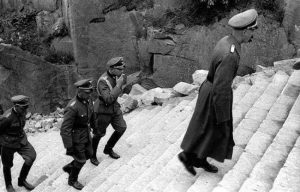 Most people who know anything about World War II, have heard of Auschwitz. Concentration camps like the infamous Auschwitz forced people to endure inhumane treatment and poor living conditions. It was one of the worst of the death camps set up by Hitler as part of the “Final Solution” killings of Jews, Gypsies, and Jehovah’s Witnesses during and right before World War II. Nevertheless, Auschwitz wasn’t the only death camp, and some were even more afraid of going to Mauthausen than they were Auschwitz.
Most people who know anything about World War II, have heard of Auschwitz. Concentration camps like the infamous Auschwitz forced people to endure inhumane treatment and poor living conditions. It was one of the worst of the death camps set up by Hitler as part of the “Final Solution” killings of Jews, Gypsies, and Jehovah’s Witnesses during and right before World War II. Nevertheless, Auschwitz wasn’t the only death camp, and some were even more afraid of going to Mauthausen than they were Auschwitz.
Between 1939, when World War II began, to 1945 when it ended, more than 1 million of the 1.5 million Jewish children who had lived in the areas German armies occupied, had perished. The Mauthausen camp wasn’t as well known as Auschwitz, but it was equally horrific. Built in 1938, Mauthausen was one of the first concentration camps erected and the last to be liberated. It was a place where terrible medical experiments took place, and the guards humiliated the prisoners. Mauthausen “Stairs of Death” were especially tragic because prisoners were forced to climb to their deaths. This 186-step structure was brutal for prisoners. They had to carry stones weighing more than 100 pounds from the bottom of the quarry to the top of the stairs. Climbers often collapsed beneath the stones’ weight. Exhausted prisoners slid down the steps, knocking over other prisoners while the stones crushed their limbs. Nazi Party members called the camp “the Bone Grinder.”
Prisoners who actually made it to the top of those torturous steps, were then forced to make the most unthinkable decisions. The German guards lined up the survivors of the climb, then forced them to choose between either pushing a fellow prisoner off the cliff or being executed. Many prisoners opted to jump off the cliff. German officers called these acts “parachute jumps.” It didn’t matter if they had been strong enough to make the climb, carrying the 100 pound rocks, because they were to lose their lives anyway.
Some prisoners escaped the stairs, if it could be called escape, but they were subjected to Dr. Aribert Heim’s horrific experiments. In 1941, Heim started working at Mauthausen. His experiments involved disfiguring people indiscriminately. During his first year of employment there, guards brought in an 18-year-old Jewish athlete with a foot infection. “Heim put the teen under anesthesia, cut him open, removed his kidney, and castrated him. Finally, the doctor removed the athlete’s head, then boiled the skull to remove all the flesh. He kept the severed body part as a trophy.”
Austrian winters are brutal, with temperatures dropping to around 14 degrees Fahrenheit. The guards at Mauthausen used the frigid temperatures to torment and execute inmates. They took groups outside, forced them to strip naked, then sprayed them with water. The poor terrified prisoners were the 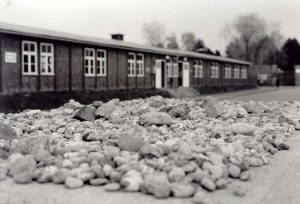 left to freeze. Many died of hypothermia. The guards also “enjoyed” physically and mentally abusing their prisoners. Former inmate and French resistance fighter Christian Bernadac said Mauthausen was “infernal, without a second’s rest.” Officers offered prisoners breaks from the grueling work, but then executed those who accepted. Mauthausen survivor Aba Lewitt recalled a man who met that fate: “The guard said [to the man], ‘Well, then, sit over there’ – then he shot him. [He] said the inmate tried to escape the camp. That happened umpteen times every day.”
left to freeze. Many died of hypothermia. The guards also “enjoyed” physically and mentally abusing their prisoners. Former inmate and French resistance fighter Christian Bernadac said Mauthausen was “infernal, without a second’s rest.” Officers offered prisoners breaks from the grueling work, but then executed those who accepted. Mauthausen survivor Aba Lewitt recalled a man who met that fate: “The guard said [to the man], ‘Well, then, sit over there’ – then he shot him. [He] said the inmate tried to escape the camp. That happened umpteen times every day.”
The Germans created Mauthausen to benefit Adolf Hitler’s army. They needed granite and brick for Linz, a neighboring city the dictator hoped to rebuild with huge, elaborate structures. The concentration camp sat on the edge of a granite quarry, and prisoners collected the plutonic igneous rock to form Mauthausen’s main structures. Inmates called their time there “vernichtung durch arbeit,” or “extermination by work.” They did not expect to return home.
Mauthausen was a central concentration camp, but it had numerous subcamps that surrounded it. The subcamps were connected by underground tunnels. One of these smaller subcamps, the Gusen complex, was the place they took people who were too weak to work. Gusen inmates were simply thrown on the ground and abandoned. People there were piled on top of each other, often unable to move around and covered in human excrement. German guards rarely distributed food in Gusen, so the prisoners simply starved to death.
Crazed prisoners at Mauthausen allegedly resorted to cannibalism to survive. Food was so scarce in Mauthausen, and sometimes high-ranking German guards like Oswald Pohl cut the rations in half. To stay alive, some inmates resorted to cannibalism, particularly during the winter months when other sustenance such as grass and sand was scarce. A black market of stolen meat emerged. Allegedly, “meat” came from dying inmates. Cannibalism became so rampant that extremely ill prisoners feared sleeping, afraid others might remove chunks of their flesh.
Mauthausen guards had nothing but time to come up with the most horrific ways to torture the prisoners. Sometimes they ordered them to pick strawberries in a field and then shot them…saying they were trying to escape. Concentration camp leaders also threw prisoner’s hats near the structure perimeters and shot whoever tried to retrieve their belongings. Barbed-wire fencing surrounded Mauthausen. The guards loved dangling “freedom” in front to the prisoners, or at least saying that the prisoners were trying to escape. Some inmates ended their own lives by throwing themselves against the fence. That didn’t usually end their lives instantly. The prisoner would just hang there, stuck in the wire, for days until they finally died.
Mauthausen was finally liberated when World War II ended in 1945, but many of the inmates never received 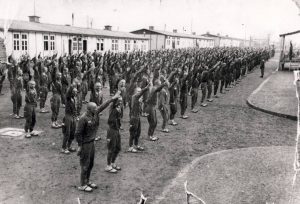 justice. They died before help arrived. The Austrian concentration camp claimed about 100,000 lives and thousands more were lost after their release. Allied soldiers didn’t understand the gravity of the situation when they arrived in Mauthausen. They were trying to help when they threw chocolate to the starving inmates. Chocolate has lots of calories, and is often given as a source of energy, but many of the inmates died, because their bodies could no longer digest solids. I can’t imagine the horror the soldiers must have felt, knowing that in trying to help, they had inadvertently caused the death of these poor prisoners. The camp was liberated on that day in 1945, but the terror that was daily life in Mauthausen will never be forgotten.
justice. They died before help arrived. The Austrian concentration camp claimed about 100,000 lives and thousands more were lost after their release. Allied soldiers didn’t understand the gravity of the situation when they arrived in Mauthausen. They were trying to help when they threw chocolate to the starving inmates. Chocolate has lots of calories, and is often given as a source of energy, but many of the inmates died, because their bodies could no longer digest solids. I can’t imagine the horror the soldiers must have felt, knowing that in trying to help, they had inadvertently caused the death of these poor prisoners. The camp was liberated on that day in 1945, but the terror that was daily life in Mauthausen will never be forgotten.
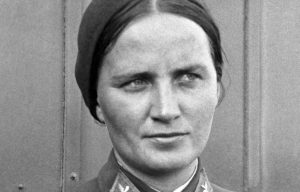
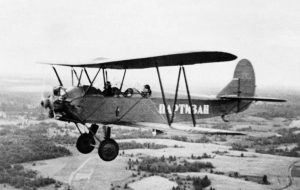 During and before World War II, and even after to a large degree, women were not allowed to hold combat positions, but the Soviets found that the enemy was fast encroaching on them, and there was no other choice. Using female bombardiers was even more undesirable, but Adolf Hitler had launched Operation Barbarossa, which was his massive invasion of the Soviet Union, in June 1941. By that autumn, the Germans were pressing on Moscow, Leningrad was under siege and the Red Army was struggling. The Soviets were desperate.
During and before World War II, and even after to a large degree, women were not allowed to hold combat positions, but the Soviets found that the enemy was fast encroaching on them, and there was no other choice. Using female bombardiers was even more undesirable, but Adolf Hitler had launched Operation Barbarossa, which was his massive invasion of the Soviet Union, in June 1941. By that autumn, the Germans were pressing on Moscow, Leningrad was under siege and the Red Army was struggling. The Soviets were desperate.
Marina Raskova, who was also known as the “Soviet Amelia Earhart,” had brainstormed the idea of a female squadron. She was famous not only as the first female navigator in the Soviet Air Force but also for her many long-distance flight records. Marina had been receiving letters from women all across the Soviet Union wanting to join the World War II war effort. Oh sure, they could go in as nurses, secretaries, or in some other support roles, but these women already knew how to fly. They had been training in air clubs all over the Soviet Union. They wanted to be gunners and pilots, flying on their own. Many of these women had lost brothers or boyfriends, and many had seen their homes and villages destroyed. Raskova petitioned Soviet dictator Joseph Stalin to let her form an all-female fighting squadron. Stalin wasn’t too keen on the idea, but it soon became apparent that they had no other choice.
On October 8, 1941, Stalin agreed to the plan and gave orders to deploy three all-female air force units. These women were going to be full-combat soldiers. They would not only fly missions and drop bombs, they would return fire too. With this action, the Soviet Union became the first nation to officially allow women to engage in combat. Previously, even women pilots could only help transfer planes and ammunition. Then, the men took over. Raskova quickly started to fill out her teams. She had more than 2,000 applications to choose from. She selected about 400 women for each of the three units. These were not long time pilots, but rather, most were students, ranging in age from 17 to 26. Those selected moved to Engels, a small town north of Stalingrad, to begin training at the Engels School of Aviation. The women underwent a highly compressed education, and were expected to learn in a few months what it took most soldiers several years to grasp. The only thing in their favor was that they already knew how to fly, just not in combat. Each recruit had to train and perform as pilots, navigators, maintenance and ground crew. Then the positions were assigned. The women faced skepticism from most of the male military personnel who believed they added no value to the combat effort, and called them “princesses.” Raskova did her best to prepare her women for these attitudes, but they still faced sexual harassment, long nights, and grueling conditions. “The men didn’t like the ‘little girls’ going to the front line. It was a man’s thing.” Assigned Polikarpov Po-2 biplanes, which was a bare-bones plywood biplane, the women flew under the cover of night. These light two-seater, open-cockpit planes were never meant for combat, and were often referred to as “a coffin with wings.” Made out of plywood with canvas pulled over, the aircraft offered virtually no protection from the elements. Flying at night, pilots endured freezing temperatures, wind, and frostbite. In the harsh Soviet winters, the planes became so cold, touching them caused skin to stick and rip off. They were given uniforms handed down from the men, and boots that were too big, and had to have the toes stuffed, so they would not slip.
In the air, they braved bullets and frostbite, while on the ground, they battled skepticism and sexual harassment. Nevertheless, in the air, they were so feared and hated by the Nazis that any German airman who downed one of these planes was automatically awarded the prestigious Iron Cross medal. All told, the unique all-female 588th Night Bomber Regiment dropped more than 23,000 tons of bombs on Nazi targets. And in doing so, they became a crucial Soviet asset in winning World War II. The Germans nicknamed them the Nachthexen, or “night witches,” because the whooshing noise their wooden planes made resembled that of a sweeping broom. “This sound was the only warning the Germans had. The planes were too small to show up on radar, or on infrared locators,” said Steve Prowse, author of the screenplay The Night Witches, a nonfiction account of the little-known female squadron. “They never used radios, so radio locators couldn’t pick them up either. They were basically ghosts.”
Due to both the planes’ limited weight capacity and the military’s limited funds, the female pilots didn’t have some of the basic necessities. Parachutes were deemed a “luxury” item. The added weight was just too much. They also didn’t have radar, guns, and radios. They were forced to use more rudimentary tools such as rulers, stopwatches, flashlights, pencils, maps, and compasses. Because these planes flew slower than the stall speed of the Nazi planes, they were very good at maneuvering out of the way of the German planes, making them hard to target. They also could easily take off and land from most locations. Still, there was a downside too. Whenever they did come under enemy fire, the pilots had to duck by sending their planes into dives, because most of them carried no defense ammunition. If they were hit by tracer bullets, which carry a pyrotechnic charge, the wooden planes would burst into flames, killing the crew.
One of the biggest drawbacks was that the Polikarpovs could only carry two bombs at a time…one under each wing. Two bombs per plane was not going to make much of a dent in the German targets, so the regiment sent out up to 40 two-person crews a night. Each would fly between 8 and 18 missions a night, returning to base to re-arm between runs. The weight of the bombs forced them to fly at lower altitudes, making them a much easier target, which is why they only flew missions at night. Each mission found the planes traveling in packs. The first planes were used as bait. Their job was to attract German spotlights, which provided the pack with much needed illumination. These bait-planes, rarely had ammunition to defend themselves. They would release a flare to light up the intended target. The last plane would idle its engines and glide in darkness to the bombing area. It was this “stealth mode” that created their signature witch’s broom sound. While these women were a formidable foe, they were also women. The Night Witches followed 12 commandments, the first of which was “be proud you are a woman.” They might be fierce killers of the Germans, but in their downtime they were still women. They did needlework, patchwork, decorated their planes and danced. They even put the pencils they used for navigation into double duty as eyeliner.
The last flight of the Night Witches took place on May 4, 1945…when they flew within 37 miles of Berlin. Three days later, Germany officially surrendered. According to Prowse, “the Germans had two theories about why these women were so successful: They were all criminals who were masters at stealing and had been sent to the front line as punishment, or they had been given special injections that allowed them to see in the night,” both of these “theories” make me laugh, like the female pilots couldn’t be just that…excellent fighter pilots in their own right. Altogether these capable, albeit “crazy” heroines flew more than 30,000 missions, or about 800 per pilot and navigator. They lost a total of 30 pilots, and 24 of the flyers were awarded the title Hero of the Soviet Union. Marina Raskova, who had spearheaded the movement, died on January 4, 1943, when her plane was shot down on a mission very near the front line. Hers was the very first state funeral of World War II and 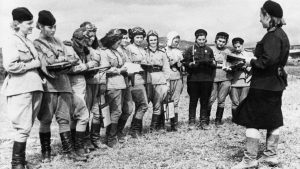
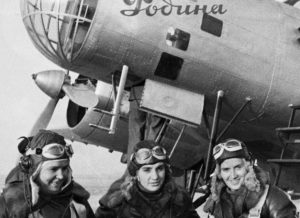 her ashes were buried in the Kremlin. The all-female 588th Night Bomber Regiment, despite being the most highly decorated unit in the Soviet Air Force during the World War II, was disbanded six months after the end of the war. When the big victory-day parade in Moscow was held, they weren’t included, because it was decided that their planes were too slow. Amazing!!!
her ashes were buried in the Kremlin. The all-female 588th Night Bomber Regiment, despite being the most highly decorated unit in the Soviet Air Force during the World War II, was disbanded six months after the end of the war. When the big victory-day parade in Moscow was held, they weren’t included, because it was decided that their planes were too slow. Amazing!!!

